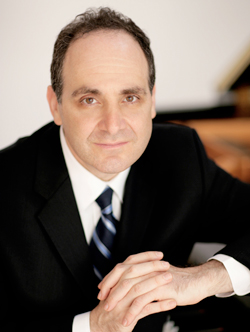by Mike Telin

The soloist in Rachmaninoff’s concerto will be Dr. Richard Kogan, a Harvard Medical School-trained psychiatrist, acclaimed pianist, and artistic director of the Weill Cornell Music and Medicine Program in New York. “For many years I’ve had parallel careers as a concert pianist and as a psychiatrist,” Kogan explained during a telephone conversation.
The two strands of Kogan’s career came together some years ago when he was asked by the American Psychiatric Association to lead a symposium on creative geniuses and mental Illness. “I started reading about composers whose music I have played my entire life, like Rachmaninoff, Schumann, and Tchaikovsky, and I realized that they had grappled with many of the same issues that patients I was seeing in my office were grappling with. It was intriguing to me that, for instance, during Schumann’s time no one had come up with a word for manic depressive illness or bipolar disorder, although it seemed like he had a pretty classical version of that illness.”
Today, Dr. Kogan is well-known for his lectures and concerts that explore the healing powers of music, and the influence of psychiatric and medical illnesses on the creative output. He has presented his work at concerts, music festivals, medical conferences, and scholarly symposia around the world. Saturday’s concert will launch Akron Symphony’s Music and Mental Health program in which ASO musicians will perform weekly in several inpatient behavioral health settings at Summa Health System.
He said that Rachmaninoff, like Schumann, is an equally interesting case study. “I think he idolized Tchaikovsky, a fellow Russian depressive and who was also writing music of supercharged emotionalism. For both of them music was a wonderful outlet for articulating some of their inner torment.”
Kogan pointed out that it was the disastrous premiere of Rachmaninoff’s Symphony No. 1 in 1897 that caused the composer to go into a full-scale depression which lasted several years. “He was feeling helpless and said he felt as if he had had a stroke. He also became convinced that he should not compose music anymore. The problem was that he retreated into his own depressive shell.”
Although Rachmaninoff had received a commission from a London patron to compose a new piano concerto, his severe depression left him incapable of composing. “Although he needed the money, he had such severe writer’s block that he couldn’t compose anything.” Rachmaninoff eventually sought the help of Dr. Nikolai Dahl, a specialist in neuro-psychotherapy.
“Dr. Dahl had gone to Paris to study hypnosis, and after he returned to Moscow he opened a practice that was exclusively devoted to treating patients through hypnosis. Rachmaninoff sought him out because Dr, Dahl was a serious amateur musician — he was a violist who founded his own string quartet.” Kogan said. “The treatment he used with Rachmaninoff was very detailed. The first part of each session consisted of cultured conversation during which Dahl explored the composer’s associations, aspirations, challenges and memories. Then he would put Rachmaninoff in a trance, and would repeat the same phrases — like ‘you will begin to write your concerto, you will work with facility, and your concerto will be of excellent quality’. After four months of this treatment Rachmaninoff started writing what we have come to know as one of the most beloved piano concertos of all time. Which he dedicated to Dr. Dahl.”
In addition to the dedication of Rachmaninoff’s concerto, Kogan believes that Dahl’s spirit can be found through the work. “Like the famous melody in the third movement that is introduced by the violas. I think Rachmaninoff did that as a tribute to him. I don’t think it is a coincidence that Dr. Dahl’s instrument was the viola.”
Kogan said that it is possible that the therapy helped to put Rachmaninoff in touch with memories from his childhood. “Although he was born into wealth, his father, through a combination of alcoholism, gambling, and womanizing, lost the entire family fortune and was forced to move to a tiny apartment in Moscow where Rachmaninoff and his older sister both contracted diphtheria. He recovered, but she died. Because of that brush with mortality, he developed a fear of death, which could be the reason he incorporates the Dies irae into so many of his compositions.” Fittingly, Hector Berlioz makes prominent use of the Dies irae chant melody at the end of his Symphonie Fantasique.
Although Rachmaninoff was never a religious man, as a child he did enjoy attending church with his grandmother. “He was very taken by the sound of the cathedral bells, which he also incorporates into many of his compositions, including his second piano concerto. It begins with an imitation of cathedral bells, and the first melodic theme is right out of Russian Orthodox plainchant. So it is very possible that the therapy put him in touch with memories of those church services that he heard with his grandmother.”
Saturday’s concert will also reunite Dr. Richard Kogan and Christopher Wilkins on the stage for the first time since they were students at Harvard. “The first concert Chris ever conducted was with the Bach Society Orchestra, and I played Beethoven’s ‘Emperor’ concerto. I really look forward to the concert, I think it’s going to be a lot of fun.”
Published on ClevelandClassical.com February 5, 2016.
Click here for a printable copy of this article



